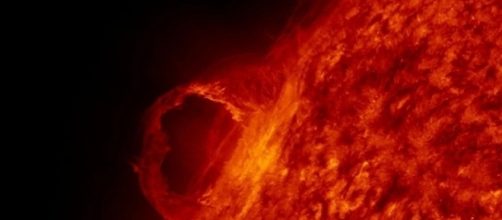Minnesota and Wisconsin in the northern half of the United States face a potentially devastating problem and are the states at the highest risk in the event of a catastrophic geomagnetic solar storm. Powerful solar storms do happen and a catastrophic one occurs around every 100 years. The earth is overdue for one to hit. According toresearchers at the US Geological Survey, the last one hit in 1859 and was dubbed the "Carrington Event." It caused massive loss of communications in Europe and the USA as telegraph went down. If you think that was bad, consider that they had only just invented postage stamps a few years before and computers and smartphones were the stuff of science fiction.
It was only about eight years before the "Carrington Event" that James Clerk Maxwell discoveredthe existence of electromagnetic waves that were used to power telegraph signals.
Minnesota and Wisconsin return to the dark ages
Science Alert points out that in our current society, "widespread power outages around the planet" would be devastating as we rely on electricity for almost every aspect of our modern lives. They explained that a "powerful solar ejection could potentially send us back to the Dark Ages for months or even years." While there is not a lot earthlings can do to prevent a massive Solar flare storm, researchers told the Business Insider that we can be prepared for it.
Plotting the risk map
The researchers at the US Geological Survey have been working on plotting a map to show the areas that would be worst hit and although the map is incomplete at this time, it certainly looks like Minnesota and Wisconsin are going to be at greatest risk of a massive and prolonged power outage in the USA. This does not let Europe off the hook,as field surveys have not yet been completed there. Even the US study is incomplete and has been delayed now due to a lack of funding.
It all works through geoelectricity. When the earth is bombarded by a solar storm, the worst effected areas are close to the magnetic poles. The earth contains rocks that conduct electricity, and certain rocks like sandstone are very good conductors - "which is somethingyou don't want in a catastrophic storm," according to geophysicist Jeffrey Love.
He pointed out that "Power grids are grounded, so they can pick up electric fields generated deep inside the Earth." Science Alert mentions that it is important to know which power grids are in areas of high conductivity ...and are most at risk from a solar tsunami."
Completing the project will be cheaper than consequences
Minnestoa and Wisconsin are heavily populated so finding ways to adapt or protect the power grids in case of a future event is vital. The geophysical survey has found that there are some complicated rock structures in places and they need to continue mapping the areas at highest risk. Love argues that the costs of completing the project are going to be a lot cheaper than the consequences of a massive power outage.
Continental scale failure of power grids
The research on theGeoelectric Hazard Maps project for the Continental United States does mention that we have experiened a number of recentintense magnetic storms that caused problems. For example, inOctober 2003 a solar storm caused "measurable currents in power-grid systems in Scotland," and resulted in grid failure in Sweden. This was not the big one - that is yet to come, and in the event of a catastrophic magnetic storm there could be a "continental-scale failure of electric-power grids."

